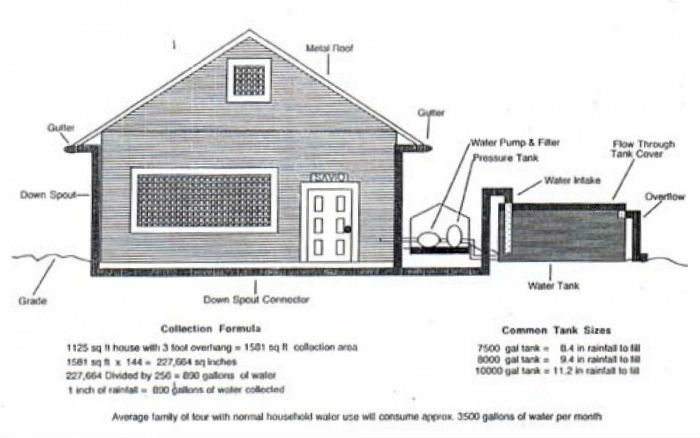Water Catchment Overview
Since county and private water service is not available in many parts of the Big Island of Hawaii it would be a good idea for you to familiarize yourself with alternative water systems. The most common one you will see is the catchment system.
Though the system detailed below is one that is used most everywhere, there are many variations to the individual components depending on the needs of the user and the area in which they reside.
We recommend that you familiarize yourself with the concept first, and then investigate the particular components included with the properties you are interested in to see if they meet your needs. If you are planning to build a new home you can expect to spend approximately $2,000 on a system that would be adequate for most households.
Water Catchment Subsystem Components
A rainwater harvesting system consists of the following subsystems: catchment area (roof), conveyance system (guttering, downspouts, and piping), filtration, storage (cistern), and distribution.
3.1 Catchment Subsystem
Rainwater harvesting can be done with any roofing material, if it is for non-drinking use only. For potable use of rainwater, the best roof materials are metal, clay, and cementitious - although all roof material types have been used (except asbestos). Asbestos roof materials used in older homes should not be part of a system to provide drinking water. Asphalt shingles can contribute grit to the system and need a pre-filter for the water before it enters the cistern. Lead materials in any form should not be used in the system (i.e. lead flashing).
3.2 Conveyance Subsystem
Gutters are used to convey water from the roof to pipes to the cistern.
- If a straight run of gutter exceeds 60 feet, use an expansion joint.
- Keep the front of the gutter one half inch lower than the back.
- Provide a gutter slope of 1/16 inch per foot minimum.
- Provide gutter hangers at 3 feet O.C.(on center).
- Gutter should be a minimum of 26 gauge galvanized steel or 0.025 inch aluminum.
- Downspouts should provide 1 square inch of downspout opening for every 100 square feet of roof area.
- The maximum run of gutter for one downspout is 50 feet.
- The conveyance piping from the gutter system to the cistern or filter should be Schedule 40 PVC or comparable in a 4 inch diameter. Do not exceed 45 degree angle bends in horizontal pipe runs and provide 1/4 inch slope per foot minimum. Use one or two-way cleanouts in any horizontal pipe run exceeding 100 feet.
3.3 Storage Subsystem
The storage tank (cistern) must be sized properly to ensure that the rainwater potential is optimized. See the article on Water Catchment Capacity for sizing information.
- Cisterns can be located above or below ground.
- The best materials for cisterns include concrete, steel, ferro-cement, and fiberglass.
- When ordering a cistern, specify whether the cistern will be placed above or below ground and if the cistern will be used to store potable water. (Fiberglass cisterns are constructed differently to meet the various criteria.
- If using a manufactured tank designed to hold drinking water, the tank should conform to the published specifications of the American Waterworks Association.
Cistern characteristics:
- A cistern should be durable and watertight.
- A smooth clean interior surface is needed.
- Joints must be sealed with non-toxic waterproof material.
- Manholes or risers should have a minimum opening of 24 inches and should extend at least 8 inches above grade with buried cisterns.
- Fittings and couplings that extend through the cistern wall should be cast-in-place.
- Dissipate the pressure from the incoming water to minimize the stirring of any settled solids in the bottom of the cistern. This can be accomplished in a concrete cistern by placing concrete blocks (cavities facing upward) surrounding the base of the inlet pipe. The blocks can be 8"x 8"x16" blocks with the pipe exiting one inch above the bottom of the cistern. Baffles to accomplish the same result can be made as part of fiberglass cisterns. This is not a concern for cisterns that always have a large reserve.
- The use of two or more cisterns permits servicing one of the units without losing the operation of the system.
- Have a fill pipe on the cistern for adding purchased water as a backup.
- Have a cover to prevent mosquito breeding and algae growth from contact with sunlight.
Additional Info
- Published in Home Improvement and Maintenance


